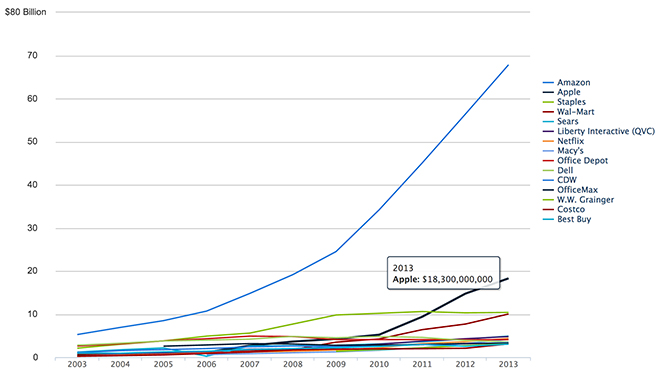Amazon Web Services is already the 800-pound gorilla in cloud. It offers five times the utilized compute capacity of its next 14 competitors combined and is arguably the fastest-growing software business in history. According to Amazon CTO Werner Vogels, however, this isn’t nearly ambitious enough. AWS aims to become an 800,000-pound gorilla.
That’s because Amazon isn’t in the business of “infrastructure as a service,” as the process of setting data services such as storage and computation is dubbed in a jargony way. According to Vogels, Amazon is in “the business of pain management for enterprises.” And there’s a whole lot of pain to manage these days.
Amazon’s Dominance Problem
While not a bully, Amazon tends to dominate the markets it gets into. In retail this means that Amazon outsells its nine closest competitors, combined. While we like to fixate on the success of Apple stores, they move just a fraction of the product Amazon sells, according to data from Internet Retailer:

See also: Google’s Secret Weapon Against Amazon: Blisteringly Fast Networks
Amazon’s retail business generates roughly $70 billion in revenues. In an interview with Recode, Vogels insisted that Amazon has every intention of making AWS as big or bigger than its retail operations:
This is a business that will be as big as our retail businesses if not bigger.… It took us six years, or until 2012, to get to 1 trillion objects stored. Then it took us one more year to get to 2 trillion. So that’s an indication of the speed of growth. To my eyes, that it only took a year to get to 2 trillion, it looks like the onset of a hockey stick.
In other words, that huge delta between AWS and its cloud rivals? Amazon expects it to get even bigger.
Competitors? What Competitors?
When asked about competitors, Vogels was quick to assert that Amazon doesn’t think about what other cloud providers are doing except “when we want to understand why someone might want to choose something other than AWS.”
Let’s assume he’s telling the truth, and the company is completely customer-centric, and not too bothered by what Microsoft or Google might be up to (which might not be wise, as I’ve argued here and here).
The reality, however, is that AWS is a bigger threat by far to established software companies than to cloudy new providers. As Credit Suisse IT executive Zohar Melamed states it:
@mjasay @Werner @ahess247 All the 'inside the firewall' cloud vendors are selling generators. These guys sell electricity.
— Zohar (@zohar_melamed) July 23, 2014
In other words, Amazon’s rise, as troubling as it may be to its cloud competitors, spells the end of an enterprise software era. That’s got to keep the Oracles of the world up at night.
Lock-in Rising?
So competitors should be worried, but what about customers? With so much of modern workloads running on AWS, do enterprises risk locking themselves into the next Microsoft?
Definitely maybe.
Vogels, of course, says no way:
[Amazon has] worked really hard at not locking our customers in…. There’s no lock-in. Many of our services are really accessible from standard protocols. I’ve never gotten any feedback from our customers saying “please don’t build this.” They all say “please build more….” It’s the same story around standardization. I’ve yet to have a customer say they’re not going to use our stuff because it’s not standardized.
Yet according to one AWS partner, Eucalyptus CEO Marten Mickos, the only real way to avoid lock-in is through standardized open source software. As Mickos writes, “What to a customer first looked like an exciting new piece of software—easy to try, no strings attached—soon infests the organization and isn’t quite as easy to remove.” So, he suggests, “By using industry-standard open source software products, you reduce your lock-in down to an absolute minimum.”
AWS runs on a lot of open-source software, of course, but it’s not open source itself. While I doubt AWS spends any time trying to find ways to lock its customers in, the reality is that many will be.
Not because the code is closed so much as because we keep wanting to build more and more within AWS, just as we used to want to build everything with the Microsoft stack. In sum, while one day we may regret our new Amazon overlord, it seems we’re currently all too content to push as much of our IT onto Vogel’s shoulders as possible.
Lead image of Amazon CTO Werner Vogels by Flickr user The Next Web Photos, CC 2.0









